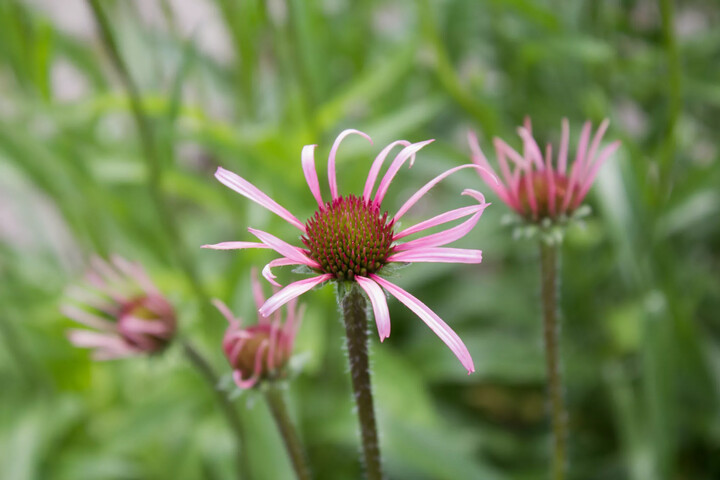Drooping coneflowers (Echinacea pallida), also commonly referred to as pale purple coneflowers, are a variety of Echinacea in the Asteraceae family. They are distinguished from other coneflower varieties by their thin, drooping pale purple or white petals. They make great additions to garden beds and borders, naturalized areas, prairies, and wildflower gardens. Their sweet nectar attracts butterflies, bees, and hummingbirds. Pair drooping coneflowers with other wildflowers such as black-eyed Susans, geranium Rozanne, catmint, and dwarf goldenrods.
Historically, echinacea has been used as a herbal remedy by the North American Indigenous people. Today, Echinacea is still utilized in natural medicine and is commonly used as a treatment for colds, coughs, and some inflammatory conditions. Echinacea pallida is one of the three varieties of Echinacea that can be used for medicinal purposes.
Botanical Name: Echinacea pallida
Common Name: Drooping coneflower, pale purple coneflower
Plant Type :Perennial
Mature Size :2-4' tall
Sun Exposure :Full sun
Soil Type: Well-draining
Soil pH :6.8-7.2
Bloom Time :Spring, summer
Flower Color :Pale pink, pale purple, white
Hardiness Zones: 3-8
Native Area: North America

How to Grow Drooping Coneflower
As with most varieties of Echinacea, Echinacea pallida are low-maintenance wildflowers that are extremely adaptable and resilient. They are native to North America, and commonly found throughout the prairies and pinelands of southern Canada and the central United States. These attractive prairie perennials are known for being humidity-tolerant, deer-resistant, heat-tolerant, and drought-tolerant. When grown in their native region, they are fairly self-sustaining and do not require much additional maintenance. Drooping coneflowers are known for their long-lasting blooms, often blooming from the early spring through to the late summer. To encourage ongoing blooming, regular dead-heading is recommended.
Light
Drooping coneflowers thrive in full sun and should receive at least 6 hours of sunlight a day. However, they are adaptable to light shade conditions but flowering may be less prominent. Drooping coneflowers cannot grow in full shade conditions.
Water
These native wildflowers have medium water requirements, although they are extremely drought-tolerant once established. When grown in their native regions (USDA zones 3-8) they should not require any supplemental watering.
Soil
Plant drooping coneflowers in soil that is well-draining as they cannot tolerate ‘wet feet’ or waterlogged soil. Drooping coneflowers are highly adaptable to poor soils, and growth may actually suffer in overly rich or fertile soils. They can adapt to both moist and dry soils, and prefer soils that are neutral to slightly acidic (pH between 6.8-7.2) but can thrive in a wide range of soil pH levels.
Temperature and Humidity
Native to the North American prairies, drooping coneflowers grow well in USDA zones 3-8. They are accustomed to warm summers and cool to cold winters, and although they are not frost-tender, drooping coneflowers cannot survive extreme freezing temperatures. They can thrive in a wide variety of temperature and humidity conditions but generally do well in hot, dry environments. They are tolerant of high-humidity.
Fertilizer
Drooping coneflower does not need to be fertilized. This perennial can survive in a wide variety of soils including poor quality soil. Overly rich or fertilized soil may cause drooping coneflowers to become leggy.
Propagating Drooping Coneflower
Drooping coneflower can be easily propagated by seed and by division. To propagate by division, wait until the late spring and choose a healthy bunch of flowers. Gently separate the root ball to isolate a new plant, and transplant immediately to a new location. Allow a couple of weeks for the coneflower to adjust to its new location - stunted growth can be expected at first!
How to Grow Drooping Coneflower From Seed
Growing drooping coneflower from seed is one of the easiest ways to grow this perennial. Seeds can be collected directly from established plants in the early to late fall, or they can be purchased from most nurseries or garden centers. A period of cold stratification may help to improve germination, but this is not necessary.
To start seeds indoors, fill pots or trays with a well-draining potting mixture. Moisten the medium and then lightly press the drooping coneflower seeds into the soil but do not cover. Place the seeds in an area that receives bright, indirect light as drooping coneflower seeds require light to germinate.